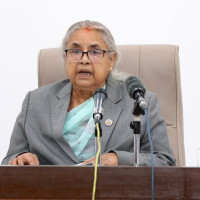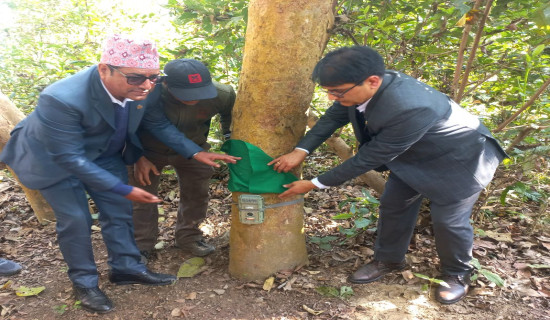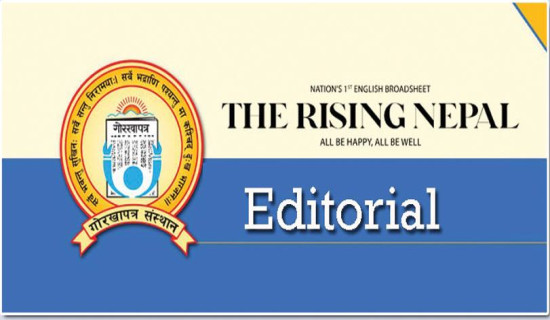- Tuesday, 16 December 2025
Save Nepal’s Agricultural Heartland
As Asar 15 approaches, the Kathmandu Valley eagerly awaits the annual dhan diwas (Rice Plantation Day). Once regarded as one of the most fertile valleys on earth, the Kathmandu Valley has now largely transformed into a concrete jungle. While we residents must accept responsibility for this change, the lawmakers and planners cannot escape blame for allowing the destruction of this once - lush, productive land. What was once vibrant farmland, largely cultivated by the valley’s indigenous communities, especially the Newars, has been steadily lost to unplanned development.
Lured by short-term financial gain and a lack of institutional support, many farmers sold their lands. The money was often used for educating their children, constructing homes on what remained of their land, or financing expensive overseas migration for younger family members. Had Nepal’s policymakers been visionary, they could have created policies to protect the valley's farmlands. Instead of letting farmers be forced to sell their property, local leaders could have promoted sustainable agricultural livelihoods.
Entrepreneurial support
With access to modern technology, digital tools and entrepreneurial support, these communities could have cultivated both their land and their economic potential — while preserving the valley’s identity and food security. In a country that has embraced a market-led economy, providing farmers with internet access, mechanisation, and training to engage in local-to-global commerce would have been a logical and just path to development. Sadly, our leaders have remained preoccupied with maintaining power rather than empowering people.
The valley could have become a model of urban-agricultural harmony, increasing rice production while preserving green spaces. Infrastructure development is, of course, a hallmark of modern civilisation. But had Nepal adopted balanced national planning, not all government services and offices would have been crammed into Kathmandu. Instead, essential services and opportunities could have been decentralised, reducing the migration pressure on the valley while revitalising rural economies.
Technologies for agriculture, irrigation, and water use could have been adapted in all regions of the country. The cooperative movement, in particular, held the promise of empowering communities through locally-driven development. These community-based institutions could have used local resources to increase production, access international markets, and stem the rising tide of youth outmigration. Unfortunately, the cooperative movement is having a backlash currently. Instead of using this to uplift the local communities by themselves and for themselves, the leaders in this sector have been involved in massive corruption. Political leaders are also associated with such corruption including fraud and misuse of innocent people’s savings.
Asar 15 traditionally marks the beginning of the rice-planting season, coinciding with the monsoon. However, the patterns of rainfall and temperature are no longer what they used to be. Climate change is slowly but surely altering the rhythm of the seasons, a fact that is observable and measurable through advanced meteorological tools and technologies. Yet the use of such technologies remains limited in Nepal.
According to the Department of Hydrology and Meteorology, about 80 per cent of Nepal’s total annual rainfall occurs during the monsoon season between June and September. This concentrated rainfall often leads to devastating consequences, especially as unplanned urbanisation and poor drainage systems increase vulnerability. In recent years, Kathmandu Valley itself has experienced severe flooding during the monsoon.
The impacts go beyond urban chaos. Glacial Lake Outburst Floods (GLOFs) and other extreme weather events linked to climate change continue to threaten lives across the country — and even extend into neighbouring nations like India and Bangladesh. In 2023 alone, monsoon-related disasters led to 79 deaths, 40 injuries, and 34 missing persons in Nepal, according to the Ministry of Home Affairs. The National Disaster Risk Reduction and Management Authority (NDRRMA) recorded more than 500 disaster events during the same period, with over 3,000 households displaced by floods and landslides.
Sadly, this year’s monsoon has already begun wreaking havoc. Reports from Nepal Police and local authorities confirm severe flooding in the Far Western Region and in parts of Kathmandu. Landslides have damaged the Mahendra Highway, obstructing movement and interrupting the supply of daily essentials. Many families who were affected by last year’s disasters have barely recovered, only to face another cycle of hardship.
Natural hazards
According to the Climate Risk Index (CRI) 2025 by Germanwatch, Nepal ranks 69th among countries most affected by extreme weather events between 1993 and 2022. Additionally, UNDP Nepal reports that 80 per cent of the population is at risk from multiple types of natural hazards, particularly water-induced disasters. This year, Rastriya Dhan Diwas (Asar 15) falls on 29th June. Traditionally, the day is marked by planting rice seedlings and feasting on dahi-chiura (curd and beaten rice), a simple yet nourishing meal for farmers. In recent years, the media has highlighted politicians and even prime ministers participating in rice-planting rituals, often accompanied by photo opportunities of them laughing and playing in the mud.
While such symbolic gestures have value, they must be accompanied by serious policy commitments. As we mark this year’s Asar 15, let it not be just a celebration of tradition, but a wake-up call. If we truly want to sustain this heritage, we must act now to protect what little rice-producing land remains. The preservation of these fields is not just about maintaining a ritual, it’s about securing our food sovereignty, our environment, and our future.
(Sharma is a senior journalist and women’s rights advocate. namrata1964@yahoo.com or on X @NamrataSharmaP.)

















